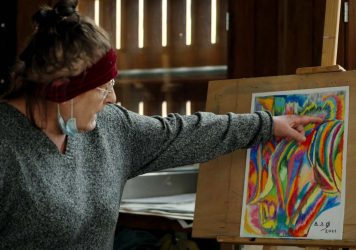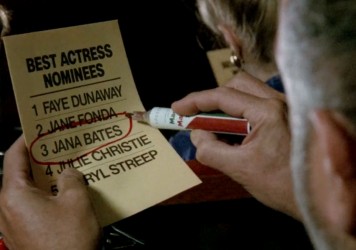
There is nothing special about a morgue in the city of Pittsburgh. One could argue there is also nothing special about Pittsburgh itself – but American experimental filmmaker Stan Brakhage decided to train his eye on institutions (policing, healthcare, coroner) in urban Pennsylvania all the same. The result was what is now referred to as his “Pittsburgh Trilogy” consisting of Eyes, Deus Ex, and The Act of Seeing with One’s Own Eyes.
The morgue situates us in the final of these films (The Act of Seeing with One’s Own Eyes), a Brakhage title that’s gained cult-classic, almost grindhouse-level status. This status really only means anything in niche cinephile circles and underground film fandom, but I think it should be required viewing in a general audience sense for the Halloween season. Brakhage achieves an extremity of body horror that splatterhouse auteurs and David Cronenberg could only strive for, but most notably, he does so without extraordinary explanation, escapist mythology, or brand construction.
That’s not to mention the fact that The Act of Seeing with One’s Own Eyes is incredibly hard to find, lending it a forbidden, taboo reputation. It’s also silent, as with all of Brakhage’s work – another tough but unusual selling point for casual moviegoers. This allows for a visual experience untethered by sensory accompaniment. You are not directed how to feel by the addition of music, dialogue, ambience, or narration. You just feel it all.
I saw a 35mm print of it at Anthology Film Archives in New York City, which was one of the most intense and exhilarating screenings I’ve ever attended. In the deafening quiet, all you could hear were people fidgeting in their seats, breathy groans, nervous laughter, and concerned whispering. A dizzying, voyeuristic camera lingers on actual cadavers posed rigidly across cold, obelisk-like slabs. Often faceless morticians handle them like manufactured goods, measuring their limbs (and genitalia, which provoked a loud involuntary chuckle from a guy in the front row), carving into skin and lifting and pulling it like taffy, scooping out brains from skull chambers with gloved hands – need I go on?

Well, I will. A couple of the most stomach-squirming scenes will forever be wriggling like nematodes through my memory, including blood being vacuumed from the corpse through a tube, and then not smoothly cascading out of it into a chasmic industrial sink. No, much worse: sputtering. A ch-ch-ch-ch motion, like a sprinkler. That one really got me. The other is a face’s flesh being snipped enough to become stretchable and rolled back entirely, exposing the inner workings beneath.
Which is more chilling – these images themselves or the thought of viewing them in total silence? The answer is both in equal measure. Brakhage extensively engaged with the distinctions between documentary and document in the context of moving images; this difference took on many forms, but the general paraphrasing is that he viewed documentary as a manipulative tradition of presenting factual occurrences as objective, without acknowledging the subjectivity inherent in the camera’s frame. Document, on the other hand, was a bit more complicated but crucial to his practice as a filmmaker. It was, as Marie Nesthus observes, not simply a matter of whether there’s “a presence or absence of the artist’s mark, but rather in the degree of its visibility.”
The Act of Seeing with One’s Own Eyes is, through and through, a document. Contrary to some of his earlier work, Brakhage shrugged off the urge here to intercut the morgue footage with more impressionable imagery, like mountains and open sky and snow, for he “knew it was impossible … to interrupt THIS parade of the dead with ANYthing whatsoever, any ‘escape’ a blasphemy.” There’s still an acknowledgement of the director’s imprint, with hyper close-ups and bodies framed in fragmented tableaux. But it’s arranged in such a way as to evoke the forceful machinations and oversight of institutional documents.
Brakhage is running us through the factory line, shoving the fine print of autopsy protocol right in our faces, prying our eyes open to make us look. In one of the starkest works of body horror, he strips away all the storytelling, all the shock, all the worldbuilding, and makes the monster our very own perception. While this has always been present in Brakhage’s work, nowhere is it done so insidiously.
It is a document in the sense that the filmmaker decided to make his imprint visible, but just barely enough to let the images and processes on display speak volumes in our registering of them. Without any literal volume – silent in often unbearable ways – this morbid work leaves all the heavy lifting on us. For that reason, it’s horror. Right to its disemboweled, de-brained core.
In a seminal essay, Stephen King argues that “When we pay our four or five bucks and seat ourselves at tenth-row center in a theater showing a horror movie, we are daring the nightmare.” While it’s a lot more expensive now (and personally, I don’t like the center of a row)King’s point is that, whether we are cognizant of it or not, we all desire the experience that horror affords. So why not add The Act of Seeing with One’s Own Eyes to that pantheon that we cycle through every October? It’s a unique class of nightmare unto itself, daring us to spend 32 un-accessorized minutes of silence in a sub-basement that doubles as a city morgue, the only thing guiding us being Brakhage’s uncomfortably intimate curiosity behind the lens.
In most horror cinema, no matter its forays into various subgenres, you’re presented with a sense of hope (the final girl in slashers), the lack thereof (everything in torture porn), a message (high-concept, A24 fare), or a bonkers playground (ultraviolent weirdo stuff like Mandy). As shocking as a more contemporary cult breakthrough like Terrifier 3 may be, it’s too…fun. The bells and whistles make it so, and it doesn’t have the leverage of real, unfictionalized gore. With this unforgettable short, you’re in Brakhage’s world, with no higher power on which to anchor your resilience. You may find beauty, you may find despair, you may find meaning, or, most likely, you’ll find nothing at all — nothing but yourself, dressed down, literally nude, and tinkered with like clockwork.
A fitting experience for the season of All Hallows: in Brakhage’s world, there is no god. No anti-god either. Only flesh.
Little White Lies is committed to championing great movies and the talented people who make them.
Published 28 Oct 2024

This humanist portrait of care, surgery and technology is Verena Paravel and Lucien Castaing-Taylor’s most overtly socially conscious work.

French documentarian Nicolas Philibert returns with a gentle, deeply moving chronicle of a floating hospital in Paris.

By Anton Bitel
David Winters’ self-reflexive slasher from 1982, The Last Horror Film, is now available on DVD.